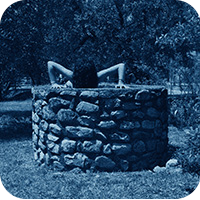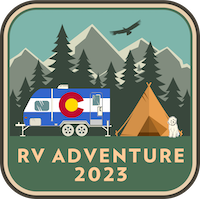Those who dwell in the gutter
Lots of travel these days which ironically provides the best blog material and the least time to write about it. More soon.
Since the time I have for composting the blogosphere is also a bit limited these days I’ve asked my pal Chris to man the marginalia link farm for a bit. Hope you enjoy his unique approach to agribusiness.
10,000
Last weekend I passed 10,000 music tracks played since I started logging them via Last.fm (then Audioscrobbler) exactly one year and one month earlier. Let’s do the numbers.
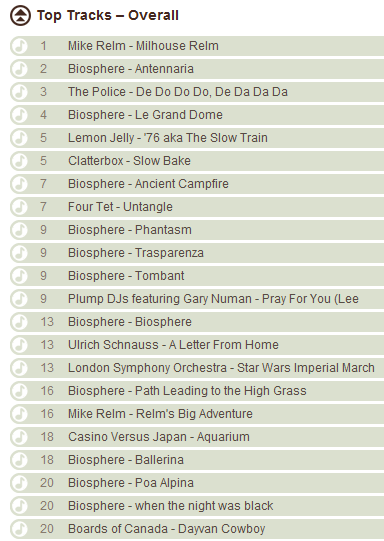
The children are contaminating my playlist. Three of the top five tracks (Milhouse Relm, a remix of the Simpsons theme, De Do Do Do, and The Slow Train) are those that I play as requests for my boys — nightly. All fine songs, of course, but not really indicative of my listening habits. It’s like my wife using my Amazon profile. You know, I don’t really care what people who bought the Epilator also bought.*
Nearly every other track is an ambient tune. This isn’t fair either, really, since I often put on albums to fall asleep to, these albums invariably being downtempo. If only Audioscrobbler logged those tracks I actually heard as opposed to those I have played. EEG interface maybe?
I don’t synch my iPod with iTunes so the tracks that I consider to be truly representative of my awake listening habits don’t get logged. But then, am I really defined by what I listen to on my commute?
The Top Artists – Overall gives a much better sense of my last year of music. Interesting that Sufjan Stevens cracks the top 20 given that I only started listening to him last month.
What I’d really like to see in 2006 are richer visualizations of the Last.fm data. I’d love to see a schematic of artists over the course of a day. Also, richer data analysis. How often do I switch from artist X to artist Y? How many times did I queue up album Z before 3pm? That sort of thing. Does this exist?
[*] 13 and 16 are also kiddie tunes. What? Of course the Star Wars Imperial March is for the kids!
“Fun” Mac products
The Apple PR machine was groaning with exertion at their announcement event yesterday. Labelled as “fun,” the products they announced were new leather cases, an iPod boombox, and a new Mac mini. The first two were accessories of course and the last was somewhat interesting in that it moves much closer to being a media center component. I’m tempted to buy it. But when I isolate what my needs really are it becomes apparent that even a Mac mini is total overkill.
All I really need is the Airport Express equivalent of an iPod video. Where is the Airport Express that has an HDMI out? This would solve my problem completely. Why put an entire computer in your AV rig when all you need is an elegant bridge?
Weakened warrior
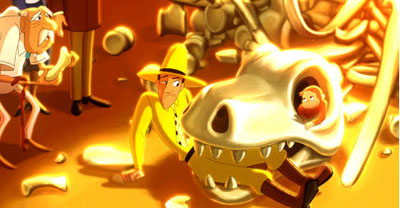
I saw Curious George with my son this weekend. Of all the plush sleeping aids that I had as a child I now retain only two. The first is my original blanket, now ripped, fringeless, and still smelling of decades-old urine from a bit of a bedwetting problem. (I don’t want to talk about it, ‘kay?) The other is my Curious George doll. Oh how I love(d) that monkey. One of my favorite childhood memories was when my mom, a nurse, would perform surgery on his armpits when he’d fray. We were fully smocked in operating room fashions. But I digress. The movie stayed true to the George I grew up loving and it manages to weave in at least parts of most of the books. I loved the ending where a triumphant Man In The Yellow Hat saves his museum by transforming it from a dusty, dull repository to an interactive, lively experience through the power of, yes, curiosity. Oh, and he and George end the movie in a rocket ship. Museums and rocket ships, wow. Where’s my yellow hat?
Staying in the spirit, my son and I built a great fort in the basement last night for movie watching, goodie-eating, and hiding from mom. We slept in it. Wow, was this a mistake. Nostalgia gone too far. My son loved it, slept sound as a rock. I slept little, alternating between being frozen stiff and just stiff from the comforter-on-concrete amenities. No bedwetting, though.
As a sidenote and just to worry my readers a little more that this is becoming a parenting blog (it’s not), my old post on cyborgs and toddlers is on the front page of Parent Hacks today.
More fun at SxSW
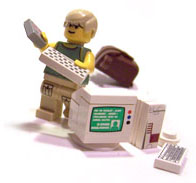
SxSW 2006 is less than two weeks away. This will be my first trip to the fest/conference/party excuse, though in certain ways both my professional and family center of gravity is in Austin (OK, one of my centers of gravity).
Because the speakers and bands and screenings simply won’t provide enough stimulus some folks have created the SxSW Interactive Playpen. Done wrong it could be as grimy and soulless as the free building areas of LEGO stores; done right — and there’s no reason to believe it won’t be done right — it could be a hell of a lot of fun. Can’t wait.
Oh, I’m also a panelist on the first day: Convergence and Transformation. That’ll be fun too. Bring some LEGO blocks.
Fellow Chicagoans Jason Fried and Jim Coudal are the keynotes.
Gonna be there and want to meet up? Let me know:
Social convergence
I’ve had some amazing moments of social serendipity lately. Call it the “small world” phenomenon or six degrees of separation minus most of the degrees, but frankly it is a bit odd. And, even though I’ve recently joined LinkedIn to explore my network of professional contacts once-, twice-, and thrice-removed, technology hasn’t contributed at all to what’s been going on.
Last week at the Special Olympics basketball tourney I wrote about I met a mom of one of the participants, a woman named Alison Leland. She was reading the New York Times in the bleachers so, this being middle-class Texas, I immediately knew she wasn’t like most of the other families there. Turns out, Ms. Leland is the wife of the late Texas congressman Mickey Leland. I only knew a bit about Mickey Leland: the causes he championed, the foes he made, the way he died. Forward a few days to New York City where I was meeting with some of the staff of the new National Museum of African American History and Culture and where, just for conversation’s sake, I mentioned this small world encounter with Ms. Leland. The team looked at me and said, “You know, the idea for this museum was Mickey Leland’s.” Hmm, small world.
This week I also learned about a computer scientist doing some interesting work in Arabic machine translation who one of my colleagues holds in very high regard. Her name is Violetta Cavalli-Sforza, a distinctive name to be sure and one that rang a bell. Now, I’m not certain of the connection, but it seems that she must be related (daughter?) to Luigi Luca Cavalli-Sforza, the father of population genetics, author of the seminal History and Geography of Human Genes, and mentor of IBM’s globetrotting co-principal on the Genographic Project Spencer Wells — a project of which I am a part. Genetic forensics, indeed!
Then last night. A friend of ours lent my wife a book she loved to help us in our struggle to find a name for our third child, due in May. It was called The Baby Name Wizard by Laura Wattenberg. This of course is also the name of the much-lauded online app (also known as NameVoyager) from last year that dynamically maps the popularity of names over time and which was created by Martin Wattenberg, Laura’s husband, and an IBM colleague of mine. I had no idea there was a book to accompany the site.
What does this prove? If the connections between the pairs of people and myself in each of these examples was a little less random it might suggest a widening professional circle. But two of the three pairs intersect my personal life too.
Oh, how I’d love this web visualized. Martin, are you listening?
City of the dead
I spent Mardi Gras this week in a New Orleans graveyard. For the second time in less than a year, though the first time since Katrina, we said goodbye to a grandparent in the vast city of mausolea called Lakelawn Cemetary. It was so much sadder this time.
Gravediggers know better than most people in New Orleans what rising water can do — which is why most New Orleans cemeteries are above-ground. Row after row of family tombs crowd the landscape like so many midget Roman temples. Last year it seemed novel, if a little macabre, to bear the casket through the alleys of the tombs to my wife’s family plot. The sun was bright. Flowers livened the drab gray houses of the deceased. Flags waved from numerous veterans’ grave sites.
This year the mood of the family was made darker a hundred-fold by the devestated cemetary, a scene very little would need to be modified in for a B-grade horror movie. On this gray day nearly every mausoleum was stained about four feet off the ground with the puke-green demarcation of high water — a grim reminder that most of the bodies of loved ones were submerged during the weeks before the floodwaters receded. If not assisting grave-side ceremonies the reduced cemetery staff (typical wait time for a burial was three weeks post-mortem) were put to work pressure-washing the horizontal bands of slime from the tombs. The grass between the rows was dead, moist, and fetid. It is difficult to say goodbye to someone you love when you are forced to imagine what might have washed out from the soaken caskets in the ooze on the ground.
Around New Orleans people were partying of course. The press made a lot of New Orleans parading on with Mardi Gras despite being so hobbled. But the truth is that the partiers seemed like actors reciting lines, going through the motions. It reminded me of the lone sober person at a party who acts crazier than the drunks in order not to be called out.
Not much has visibly changed since the last time I visited New Orleans. The city is still awash in trash, tarps, and trailers. The question I asked myself this time was: how do you start a city from nothing? Urban areas start slowly, accreting people, services, markets, and social networks over decades and centuries. But what happens when you know you want a city to exist in this spot, right now? What do you start with? Schools? OK, but what will bring the parents back? Business? OK, but who will you sell your wares to? Government? OK, but what if they’re utterly incompetent in the absence of the patronage machine that sustained them? I don’t have an answer. To me, this is less a question of disaster recovery or urban planning than one of human need. What factors begin (or restart) the gravitational pull that sucks in enough matter to create a city?
Yet good spirits persist. We bought a king cake on the way out of town. Running it through the metal detector in the airport the scanner operator said he’d tell us where the baby was in the cake for $5. When he did anyway gratis we thought he was letting us in on an Easter secret. Was the baby always in the green section? Was there some pattern than only true New Orleanians know? The operator chuckled as he said to my wife “Dawlin’, I’m runnin’ a scanna heah. I see ev’ry baby dat comes tru wit da cakes.”
The essence of sport
I saw an all-star basketball game in Houston this weekend. Nah, not the NBA one. I got to see my brother-in-law participate in a Special Olympics qualifying tournament. For a while it was hard not to get choked up whenever a game started, quite honestly. (They played 8 minute games.) These kids — some were adults, but all were children in a way — came ready to play and were as into the contest as any athlete I’ve ever seen. The joy on their faces was genuine and unbridled.
My brother-in-law, a physically-talented 16-year-old with Down’s Syndrome, stole the show. Last week he had the dubious distinction of receiving a technical foul for swearing on the court (for a not discreet “Goddamnit!”), but this week his notoriety was all the good kind. In game two his team won 8-6 on his two three-point buckets (one of which was all net) and a layup — and they play on full size courts with regulation baskets! He would run back after his shots and taunt the crowd into louder praise. It was high comedy. But there were other heros too, some of whom never even touched the ball. Autistic kids who would crack a rare smile when their team (or the other team) scored; Downs kids so severely afflicted that a high five was an effort, but one gladly made; kids with all manner of protective eyewear and headgear who would’ve suffered through the whole event in chainmail if that’s what it took to participate.
You might think that such an event would be hard on an expecting parent. The gymnasium was a collection of reminders of the ways in which the miracle of conception can go awry. But actually I felt the opposite. That gymnasium was also a collection of reminders of the way that true happiness has a way of trumping the saddest twists of fate.
How often do you get to see sport in its purest form? Competition without caustic rivalry, accomplishment without showboating? As in most aspects of life for those with mental disabilities, the tournament showed absolutely no recognition of differences in race, gender, or ability. Everyone was legitimately there to have fun. The difference between this tournament and the rowdy, gaudy crowds that poured into Houston for the NBA All-Star game all weekend could not have been starker.
If failure is an option, call back
A friend of mine recently had the amazing chutzpah to pick up the phone and call Gene Kranz, retired NASA flight director and one of the heroes of the Apollo 13 rescue. He very nearly got hung up on. But somehow, amazingly, Kranz stayed with him and they ended up having an actual conversation about NASA yesterday and today. Since then they’ve been e-mailing back and forth. Here’s an excerpt of their correspondence.
Cpt. Kranz:
Good afternoon. This is the guy that called your home and blabbered at you a few weeks ago. So a question: whether youre in a flat spin or at console getting a 1201 with 30 secs left, what goes through your mind? Is there something you go to down deep besides keeping your eye on the ball? A saying? Or is it pure focus and training?
honored,
TC
Kranz responded to TC’s somewhat nutty note with:
TC,
In crisis mode I depend on my training to get me through the first few minutes then revert to a checklist that I developed in early spaceflight and during training. See the attached. It was the key to getting through the first hour of Apollo XIII.
Cheersl
I love the use of present tense — “In crisis mode I depend on …” — suggesting that he reacts similarly to household crises in his retirement.
Here’s the checklist:
CONTINGENCY CHECKLIST
VEHICLE/CREW
1. PROBLEM INDICATIONS
2. PROCEDURE AVAILABLE
3. CRITICAL SYSTEMS
4. LIFETIME AVAILABLE
5. LIFEBOAT AVAILABLE AND INITIALIZED
6. ASSIGN TEAM TO TRACK S/C CONFIGURATION
7. DEFINE ONBOARD READOUTS
8. MAINTAIN ATTITUDE REFERENCE
9. MEMORY DUMP
DATA RECOVERY
1. TAPE DUMP/PLAYBACK
2. MCC/RTCC/CCATS CALLUP
3. DATA PRIORITY
4. VOICE TRANSCRIPT
5. DATA SECURITY
6. TERMINATE UNNEEDED EXTERNAL COMM
7. DATA ANALYSIS TEAM CHIEF
8. ARCHIVE DATA/TESTING/MFG/OTHER
MISSION IMPACT
1. CONTINUE/ALTERNATE/ABORT
2. SYSTEMS CAPABILITY FOR PLANNING
3. RETURN TO EARTH OPTIONS
4. TIME FOR GO/NOGO DECISION
5. TRACKING REQUIREMENTS
FLIGHT CONTROL TEAM
1. TEAM TAGGED UP AT ALL TIMES
2. BACKUP TEAM CALLED
3. PHASE TEAM ON STANDBY
4. MANAGEMENT CALLED
5. SPAN WORKING PROBLEM
6. RECOVERY STATUS
7. SHIFT SCHEDULE
8. PAO AND SECURITY BRIEFING
9. TERMINATE NON-ESSENTIAL ACTIVITY
10. SIMULATORS CALLED UP
11. MAKE TEAM ASSIGNMENTS FOR ANALYSIS,-/OPTIONS/PROCEDURES
CAUTIONS
ASSURE COMM DURING MANEUVERS
IMPACT OF NEXT CRITICAL FAILURE
VALIDATE GROUND/CREW INDICATIONS
LIMIT CREW RECONFIGURATION
SLOW AND CONSERVATIVE
Now, I’m not a director of space missions (though god knows I should be), but I’m going to try using this checklist next time one of my projects runs into trouble. Perhaps tomorrow? Will let you know how it goes.
Rebound
Wow, I didn’t exactly bounce back from the Turkey trip like I thought I would. Here’s what I have been meaning to post. Unrelated, all of it.
The news that they’ve found a new tomb in the Valley of the Kings is, well, big news. This is the first such new discovery since Carter found Tut in 1922, though no one seems to mention that Kent Weeks’ re-discovery of KV5 in 1995 is actually just as profound — possibly more so. I’m skeptical that the new tomb, called KV63, will create as many questions as KV5 did and does. From the scanty information it seems like KV63 was a cache or waypoint or merely a lesser noble’s attempt to flank the pharoahs’ tombs. Time will tell, but one thing is certain: count the references in the media to Zahi Hawass, head of the Egyptian Supreme Council of Antiquities, versus the number of references to Edwin Brock and Otto Schaden, leaders of the team who actually found the tomb, and you will get a sense of how things go now for archaeologists in the Egypt.
When was the last time the word “museum” was used to sex something up? Never comes to mind. Well, not at the former Chicago Historical Society which has been newly rebranded the Chicago History Museum. While former director Lonnie Bunch takes the helm of the newly-placed National Museum of African American History and Culture on the Mall in DC, the CHS has dropped the S to seem more inclusive, less upper-crust. Maybe “museum” is better. Though the etymology of the word as a cage for muses suggests old-fashion animals-behind-bars zoos, “museum” at least has an egalitarian sense that “society” does not. Better than the Exelon Chicago History Adventure, I suppose.
On the flight back from Turkey I sat next to a retired DEA agent who had made Istanbul a part-time home. In the 1990’s he was stationed there with the task of evaluating the anti-narcotics programs of the former Soviet ‘stans. He had tons of fascinating stories and, though we did no drugs, his penchant for drinking scotch hand over fist didn’t do me any favors. See not bouncing back from the jetlag, above.
Songbird, the open source, Mozilla-based media player is out in pre-alpha proof-of-concept form. It does little more than play music now, but the interface is awash in non-functional functions that really make you think this could be an iTunes killer if it is sustained and, most importantly, if the development community seizes the add-on opportunities as they have with Firefox and Thunderbird. I am keeping my eye on this one.


